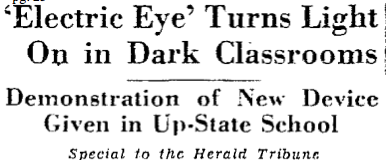
The little problems of perfecting radio and creating trans-continental television signals weren’t the only things that General Electric’s Schenectady scientists were working on in the late 1920s. In 1929, they announced a breakthrough called the “electric eye,” which was intended to ensure classrooms were properly lit.
“The teacher will no longer be required to turn on the lights in her schoolroom on dark afternoons or other periods of the day when artificial illumination may be necessary. A small automatic electrical device, developed by General Electric research engineers, will do this for her and when the electric lights are no longer required this same device will automatically turn them off.”
A demonstration of the device was given at the Edison School in Schenectady, where officials were apparently very excited at the prospect of teachers not having to flip a switch.
“The device consists of a box about the size of a radio receiving set. On one end is a lens which allows light to fall upon a photo-electric tube, better known as an ‘electric eye.’ This is set for a certain degree of daylight intensity. Whenever the light from outside falls below this mark, the ‘electric eye’ causes a small relay to switch on the lights.” (The term “electric eye” continued in use at least into the ’70s, as I recall, but now seems to have been replaced by “light sensor” or “photo sensor.”)
The educational problem being solved was once again a failing of our teachers:
“Teachers with large classes … sometimes forget to turn on the lights when artificial illumination is necessary,” Superintendent Stoddard explained. “In some rooms the teacher’s desk may be much nearer a window than some of the seats of pupils in a far corner, and she may not realize that those pupils are perhaps straining their eyes because of insufficient light. This device will relieve the teacher of this responsibility. Immature eyes of children may be permanently affected by strain put upon them while they are in development. That is why I feel this device should be one of the most important that has come into the schools in years.”
Today, of course, any such device is put in place primarily to ensure we’re turning the lights off, not keeping them on.
